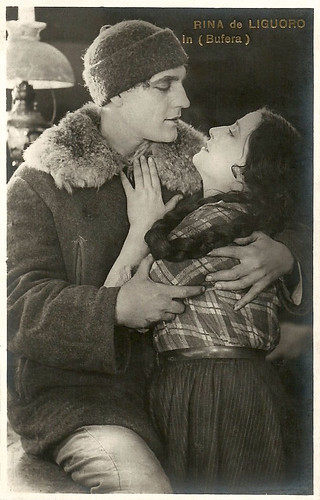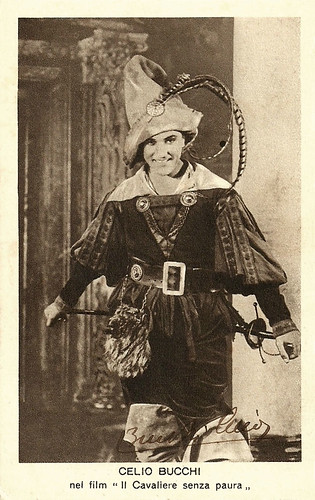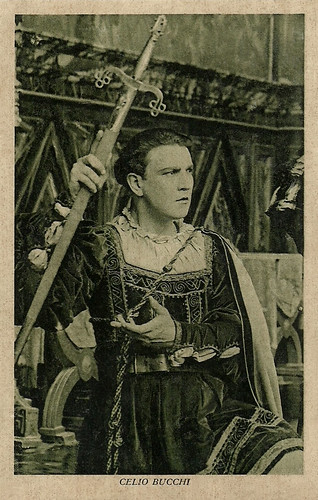
Italian postcard by Ed. G.B. Falci, Milano, no. 388. Rina De Liguoro and Celio Bucchi in the film Bufera/Storm (Wladimiro De Liguoro, 1926). Bufera is a mountain drama about a woman seduced and abandoned by a rude mountain man, leaving her with a child. When finally her life seems to retake thanks to another, kinder man, the first one reappears. Luckily a mountain storm (hence the title of the film) will swallow the inconvenient intruder.
Athletic, vigorous and tall
Celio Bucchi was born in 1886 in Lugo di Romagna, the same place where Luciano Albertini was born. Bucchi was also as athletic, vigorous and tall as Albertini. On the advice of a friend, the famous Italian illustrator Marcello Dudovich, Buchi entered the film business.
In fast succession, he acted in films at Americanfilm, Audax, Cinegraf and Latina Ars, all in Turin. His early films were with director Luigi Mele, and later on also with Salvo Alberto Salvini and Alfredo Tettoni.
Success came with La congiura di San Marco/The Conspiracy of San Marco (Domenico Gaido, 1924), the sequel to Il Ponte dei Sospiri/The Bridge of Sighs (1921) with Albertini. In this film Rolando Candiani (Amleto Novelli) has become the Doge of Venice and his great aspiration is to satisfy all the needs of the Venetian people and to defend the integrity of the Venetian Republic.
However, the followers of the ex-Doge Foscari conspire against him. But Candiano is helped by Scalabrino (Bucchi), a gentleman who has become the head of a band of acrobats, and by Zanze (Bianca Stagno-Bellincioni), a woman of the people. Together with a monkey, these two manage to prevent all the traps of the enemies and save Rolando. For several reasons, all major parts were played out by new actors.
Celio Bucchi got the part of the gentleman bandit Scalabrino, a part which in Il Ponte dei Sospiri was performed by the massive and robust harbour worker Onorato Garaveo, who had already left the cinema and returned to his former employment. When Scalabrino is heavily wounded and falls in the hands of his enemies, audiences held their breath. But soon they were relieved when all came well and the film ended with Scalabrino's justified marriage with his Zanze.

Italian postcard by Calcografia Gazettino, Venezia (Venice). Photo: publicity still for Il Cavaliere senza paura/The Knight without fear (Giuseppe de Liguoro, 1925).
No traces left
Celio Bucchi played the title character in Nostradamus (Mario Roncoroni, 1925). In that year he also played in Il Cavaliere senza paura/The Knight without Fear (Giuseppe de Liguoro, 1925) and Hôtel Saint-Pol (Mario Roncoroni, 1925). The following year he acted in Bufera/Storm (Wladimiro De Liguoro, 1926), a mountain drama with Rina De Liguoro.
In Beatrice Cenci (Baldassarre Negroni, 1926), starring Maria Jacobini as the murderess of her - evil - father, Bucchi was Amerigo Caponi, the good governor of Castel Sant’Angelo. In the propagandistic I Martiri d’Italia/The Martyrs of Italy (Domenico Gaido, 1927) which linked the fascist March on Rome with a long list of Italian heroes, Bucchi had the part of the famous historical hero Cola di Rienzo.
Opposite Elena Lunda and a young Vittorio De Sica, he played in La compagnia dei matti/Company and the Crazy (Mario Almirante, 1928). In 1927 Bucchi was paired again with Rina De Liguoro and with Bartolomeo Pagano in Il Vetturale del Moncenisio/The Carrier of Moncenisio (Baldassarre Negroni, 1927), and again in 1929 with De Liguoro in Assunta Spina (Roberto Roberti, 1929). In the latter Bucchi played the lawyer, who courts Assunta (Rina De Liguoro) and who is eventually killed by Assunta’s lover Michele (Febo Mari). This was probably Bucchi’s last silent film.
At the Quirinus studio of Rome, during the shooting of Assunta Spina, Giovacchino Forzano came to organise the shooting of Ginevra degli Almieri/Geneva of Almieri, based on his own works. For several reasons such as the adoption of sound cinema, the project went up in smoke, but Forzano took a liking to Bucchi. When he opened the Tirrenia sound studios near Pisa in the mid-1930s he took Bucchi along as warehouse manager. As an extra, Bucchi acted in almost all the films shot at the Tirrenia studios, from Der Kaiser von Kalifornien/The Emperor of California (1936) by and with Luis Trenker to Ore 10 lezione di canto/At 10 am singing lesson (Marino Girolami, 1956) with Claudio Villa. It was Bucchi’s last film.
These ca. 20 sound films meant marginal parts for Bucchi which didn’t leave any traces, not even in the most detailed filmographies. The last ones who remembered him, such as Forzano’s daughter Rita, recalled him as a big, sturdy man with a mass of blond hair and the physique of an imposing ex-athlete. Celio Bucchi died in Pisa in 1964. He was married to Jones Dalto.

Italian postcard by SRM, no. 3169.
Sources: Vittorio Martinelli (Maciste & Co.), Vittorio Martinelli (Il cinema muto italiano), and IMDb.
This post was last updated on 20 August 2023.
No comments:
Post a Comment